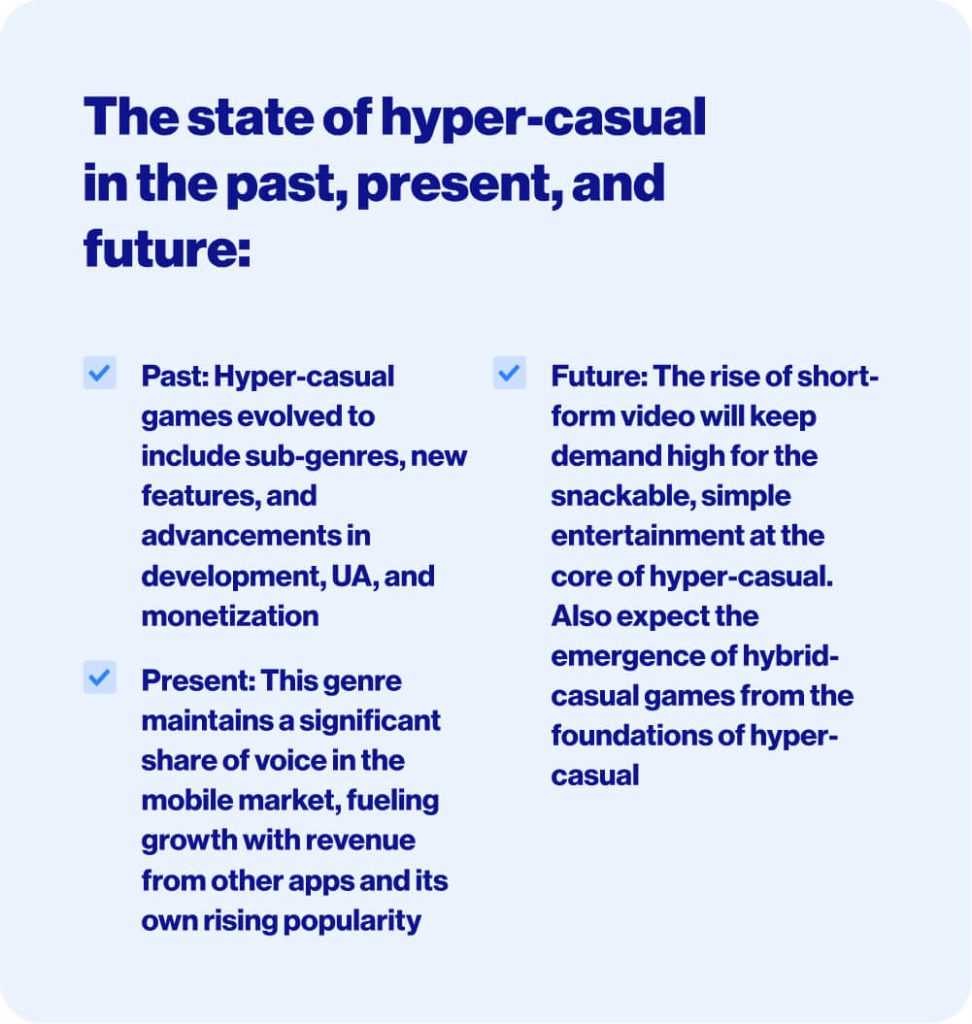Since coming onto the scene just a few years ago, hyper-casual games have experienced an exponential surge in growth. From Q1 2017 to Q2 2021, for example, the share of voice of hyper-casual installs among all total US mobile game installs grew from a few percentage points to 40%.

Where this category emerged from, its position now, and its likely path in the future can help you understand how to take advantage of its success and prepare for impending industry shifts - no matter what genre your games are.
To provide these insights, Nadav Ashkenazy, SVP & GM Supersonic, shares his take on the hyper-casual genre and its past, present, and future. Catch his full presentation from AppFest at the end of this article and keep reading for a comprehensive overview of the state of hyper-casual.

The past: Evolution of the hyper-casual industry
Tracing back the hyper-casual genre to 2013, this is the year Flappy Bird was published. It was the first game to show off hyper-casual characteristics, like short levels and simple, accessible gameplay.
From 2013-2016, most hyper-casual games scaled with cross-promotion campaigns and organic installs - a shift that you can learn more about in Omer Kaplan’s Gamefest presentation. Then in 2017, developers managed to grow hyper-casual games just like other genres - using paid user acquisition. Despite their low LTV compared to casual or mid-core games, hyper-casual games proved they could be profitable at scale. As a sustainable business model for growing hyper-casual games emerged, more publishers began focusing on this genre and the market became more competitive.
Over the next few years - and particularly after 2017 - sub-genres within hyper-casual emerged. For example, 2019 saw the rise of the ASMR hyper-casual games and 2021 was the year of TikTok-based concepts.
As these games evolved, the depth of the content grew, too. The first hyper-casual games were on an endless loop, focusing on simple gameplay that repeated itself. The rise of sub-genres and new hyper-casual concepts introduced more complex level structures, a larger amount of content, and new ways to progress. Additionally, meta features, like providing skins as rewards for progressing instead of as a default monetization approach, added another layer of complexity and depth to the core game loop.

With the evolution of hyper-casual games, the processes of developing, monetizing, and marketing them improved, too - as a result, the entire business model evolved further:
- Development: Faster development time, better-quality execution, and more accurate marketability prediction tools and approaches
- Monetization: Deeper meta, more in-app purchase and rewarded video monetization opportunities, late retention and LTV optimizations, greater variety of A/B tests
- UA: Predict LTV up to day 180, bid granularly based on user quality, and access enhanced creative optimization capabilities
The present: Hyper-casual games boost growth in overall mobile market
Today, the hyper-casual market earns $2-2.5 billion in revenue and achieves approximately 17 billion installs per year - about 1.8 billion of which come from the US. This amount of revenue and scale fuels growth in the larger mobile market, indicated by the fact that as hyper-casual installs increase, non hyper-casual installs do, too.

This comes down to the fact that as hyper-casual games became popular, more non hyper-casual titles relied on hyper-casual supply for their UA campaigns, rather than social media channels. In fact, about 20% of the installs for casual and midcore games on SDK networks now come from ads displayed in hyper-casual games and 51% of apps advertising in hyper-casual games are IAP-based titles.

Meanwhile, hyper-casual advertisers represent 30% of the video ads shown on SDK networks - more than any other genre, indicating their importance in the market.
Hyper-casual advertisers represent 30% of the video ads shown on SDK networks - more than any other genre.
As the success of non hyper-casual games becomes more intertwined with that of hyper-casual games, the growth of hyper-casual becomes fundamental to the growth of the overall mobile market - these install and advertising numbers show that it’s not just correlation, it’s causation.
The future: Hyper-casual is here to stay, with a twist
Looking to the future of the hyper-casual industry, we can break it down into two main themes:
- Short-form entertainment will keep user demand for hyper-casual high
- Hybrid-casual games will emerge from the foundations of hyper-casual as a new category
Demand for short-form content keeps attracting hyper-casual users
The demand for short-form, snackable entertainment is higher than ever - just look at the popularity of TikTok, Instagram Reels, and YouTube Shorts. This is precisely the type of content that hyper-casual games provide and why they’ll continue to grow in popularity well into the future. The execution level of these games is also increasing and the ad experience is improving, which is further helping to attract and retain users.
The demand for short-form, snackable entertainment is higher than ever, which is precisely what hyper-casual games provide.
However, as costs rise and LTV will need to increase with it, a new category will emerge alongside hyper-casual: hybrid-casual.
The rise of hybrid-casual
The hybrid-casual genre maintains the fundamentals of traditional hyper-casual games, including:
- Quick prototyping
- Simple and engaging gameplay
- Emphasis on high marketability
- Short sessions

And it evolves upon these foundations by introducing deeper gameplay, a greater reliance on IAPs, and more advanced LiveOps. With their hybrid monetization strategy, these games get the best of both worlds:
- Ad monetization for quick, high-converting revenue
- In-game purchases for higher retention and LTV
As the hyper-casual genre evolves with the market, expect its growth only to increase and continue driving forward the larger mobile industry.
Check out Nadav's full session at Appfest here:


